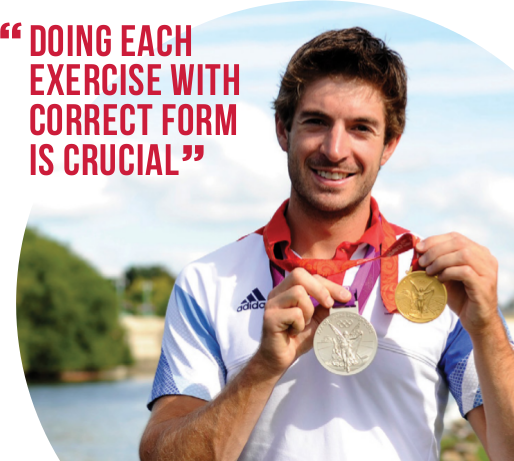Olympic Gold Medalist Zac Purchase Shares His Training Secrets
Share
Zac Purchase won a Gold medal in Bejing in 2008, and a Silver medal at London 2012
One Olympic cycle on, Zac is sharing his training secrets as a personal trainer, whilst he launches his first HIIT and functional training studios in Marlow, Buckinghamshire (www.zacsfitness.com).
“Typical training would cover the important areas of fitness muscular strength (strength), muscular endurance (speed), cardiovascular endurance (stamina) and prehab (stability),” he explains. “As a rower I would focus on endurance (cardio and muscular) for two days, and then spend a day translating this to speed. This is then repeated at a higher intensity before taking the seventh day as recovery.
Here are four exercises to do in the gym, which will help build up key muscles for rowing:
1: Deadlift (3 sets x 10 reps)
Progression: Superset deadlift to plyometric box jump.
Good For: Improving leg strength and posterior chain. Utilises core when done with good posture.
2: Inverted Bar Pull (3 Sets x 10 Reps)
Progression: Raise feet off the floor onto a bench or similar.
Good For: Using back and arm muscles similar to as used in rowing. Also uses posterior chain and core to maintain good posture.
3. Bench Press (4 Sets x 8 Reps)
Progression: Superset with plyometric medicine ball throw immediately after finishing last rep.
Good For: Creating balance with inverted bar pull – all exercise programmes should try balance opposing muscle groups. The plyometric aspect is reverent to rowing technique as your arms have to be able to move quickly and accurately at the end of the stroke.
4. Russian Twist (3 Sets x 12 Reps)
Progression: Sit on a bosu or balance plate to increase the need to use core to stabilise.
Good For: Developing strong yet mobile core, particularly obliques and stimulating the muscles needed to balance a boat.
If you are really keen to push yourself on the rower, here are three ergo tests that Zac reccommends:
All rowing workouts should be done at resistance level 3-5 if using a Concept II ergo (or use the menu settings to set the drag factor to 135 for the ultimate in consistency between machines). There is little to no benefit to using anything else as this resistance mimics the feeling of a boat the closest.
2-3 Sets of 6KM (Stroke Rate 18-19)
Have 60 seconds rest to drink between each set. Focusing on improving cardiovascular base, start at a nice and steady pace where you can still (just about) continue a conversation.
30 Mins Max Power (Stroke Rate 20)
Think about pacing and how far you can go in the time. Aim for a split time 7 seconds faster than your 2-3 x 6km.
Perform 3KM (Stroke Rate 24) Then 2 KM Max Power Without Rest
This is good for improving your top-level speed and pushing that lactate acid threshold.
Doing each exercise with correct form is crucial to using as many muscle groups as possible. Quite often it’s not a case of training more but training better to increase your improvement rate. Your body adapts in 4-6 weeks (8-12 sessions), so after this amount of time/number of sessions, change things to keep your body adapting to new challenges. Of course, the benefit from training is only as good as your recovery, so getting the right balance of food and rest is vital. I can recommend bars from Primal Pantry, which are a really easy (and tasty) way of getting some simple good quality nutrients after a session. You need to refuel within 20 minutes, so a bar is perfect.






















FOLLOW BESTFIT